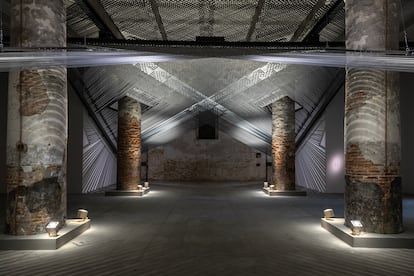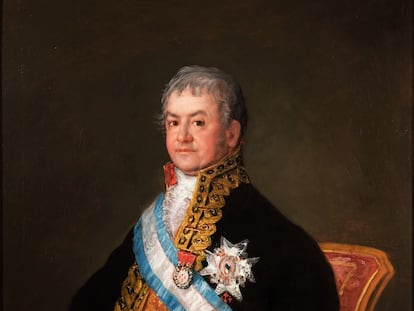A celebration ‘of the immigrant, the foreigner, the queer and the Indigenous’: Historically excluded take over at the Venice Biennale
The grand gathering of contemporary art celebrates marginalized identities with a ground-breaking edition in which artists from the global south, many of them largely unknown, are in the majority
The historically excluded have taken the reins at the Venice Biennale. The foremost event in the world of contemporary art opens the doors of its 60th edition on Saturday in the Italian city with a celebration of “the immigrant, the foreigner, the queer and the Indigenous,” in the words of its Brazilian artistic director Adriano Pedrosa. The curator has devised an itinerary guided by a new ideal of the imperative decolonialization of culture. The vast majority of selected artists — 200, from other historical eras, and 100, contemporary — hail from the global south. Hardly any of them had present at the event before, and many are true unknowns. Pedrosa’s edition is an invitation to sit with all that has been ignored throughout the biennale’s 130-year history — and, by the art world and society as a whole.
Pedrosa, director of the São Paulo Art Museum (MASP), is the first Latin American to assume this role, one of the most coveted positions in the cultural sector. He is also the first openly queer curator to lead the biennale. And, the first to travel to countries like Kenya, Zimbabwe, Angola, Indonesia, Guatemala and Paraguay to search for artists, a list admirable in its geographic scope. “I felt I had a mission,” he said on Monday as he put the finishing touches on the exhibition.
In truth, non-Western art and pieces made in collective have counted with high-profile presence in recent events, such as Documenta 2022 and the São Paulo Biennial 2023, which featured 80% non-white artists. But their prominence in a biennale as canonical and Eurocentric as Venice implies a certain consecration. “It is natural that these are increasingly dominant themes, because they mark our current moment. I wanted to make a proposal that was very political, but also very poetic,” says Pedrosa.
At the Giardini’s central pavilion, the nuclear white of its neoclassical building has been replaced by a colorful motif representing the flora and fauna of the Amazon, the work of the MAHKU collective of artists from the huni kuin culture, which originated on the border of Brazil and Peru. This edition’s theme, Foreigners Everywhere, denounces the displacement of subaltern identities, but also praises the creativity that emanates from their marginality. The biennale’s main exhibition, which traditionally consolidates a major art world trend, proposes an alternative genealogy of the art of the last two centuries (particularly, the 20th) through a back-and-forth exchange between historical eras that eludes the tutelary figures of European modernity. The south, for once, occupies the position of the north.
This year’s itinerary opens with a tribute to the exiled people of the world, a work by Egyptian artist Nil Yalter, who will receive the biennale’s 2024 Golden Lion Award alongside Anna Maria Maiolino in recognition of their lengthy careers. In the next gallery, dozens of abstract objects created outside of Europe hang, from the asymmetric geometries of Turkey’s Fahrelnissa Zeid to the sensuous volumes of Cuba’s Zilia Sánchez. They are hybrids of European teachings and local traditions, an artistic attitude that Pedrosa unironically compares to “cannibalism”.
A little further on, a corridor strings together Louis Fratino’s queer portraits with Dean Sameshima’s photos of gay porn theaters and a series by Miguel Ángel Rojas on cruising in a 1970s Bogotá theater. Later comes the naïf art of two Guatemalans, grandfather and granddaughter Andrés and Rosa Elena Curruchich, who documented everyday life in their community. So too did Haitians Sénèque and Philomène Obin, creators of delicate vignettes depicting their daily rituals, and Yanomami painters, whose works arrived from the Amazon.

In the Italian city’s Arsenale, a monumental historic complex of shipyards and armories, the Maori collective Mataaho welcomes visitors with a wink at the optical games of Brazilian artist Lygia Pape. Morocco’s Bouchra Khalili invites several migrants to paint their routes of exile on a map. Spain’s Iván Argote presents “a decolonial fiction” in which a monument to Columbus is transported in a truck through the streets of Madrid, observing the dazed reaction of passers-by. And Mexico’s Bárbara Sánchez Kane presents several military mannequins whose uniforms poorly conceal the fine lingerie they wear underneath.
The tale of this biennale, which favors catalogue over interpretation, draws a world of invisible alliances between subjected individuals and groups of different kinds, who share only their transversal condition of exclusion. At times, the comparison becomes unintelligible, as in contrasting Aloïse’s art brut, which inspired Breton and Dubuffet, with Liz Collins’ modern tapestries, “fantasies of queer utopia.” Or, upon confronting the anodyne portraits by Giulia Andreani alongside a delicate mural on textile by Madge Gill, an autodidact who painted under hypnosis during the first half of the 20th century.
Adriano Pedrosa, biennial curator: “I’m aware of not having made an exhibition of landscapes, but rather, politics. I am not afraid of controversy, it is natural”
In another gallery in the same complex, Pedrosa has exhibited dozens of works by Italian artists who emigrated to the rest of the world on the legendary concrete-and-glass easels designed by Lina Bo Bardi, the Roman architect who went into exile in Brazil following World War II. It is possible to see the political commentary in this gesture regarding the Italy of prime minister Giorgia Meloni, to whom Pedrosa seems to offer a reminder of how her compatriots were themselves the undesirables in other places and times. “It’s a provocation,” admits the curator. “I am aware of not having made an exhibition about landscapes, of having chosen a political theme. I am not afraid of controversy, it is natural. It forms part of the process if you are interested in dealing with contemporary issues.”
Geopolitical context has certainly entered into this edition of the biennale, as per usual in Venice. After the self-suspension of the exhibition of Israeli artist Ruth Patir, a hundred protestors demonstrated on Wednesday in front of the Israel and United States pavilions, which happen to be neighbors. The former was renamed “the genocide pavilion” by protestors. Hours earlier, the biennale’s new president, Pietrangelo Buttafuoco, had said of its non-opening. “To quote Magritte, this is not a pavilion. It is an artistic fact, it is the genius of art in knowing how to find a response,” said the journalist and writer, who is a supporter of Meloni and Matteo Salvini, vice president of the Italian council of ministers, and was an ultra-right militant in his youth.
If the biennale itself has maintained a much-criticized neutral stance, in various exhibitions, winks at solidarity with Palestine abound. A large mural work by Mexico’s Frieda Toranzo Jaeger includes several watermelons, symbol of the Palestinian resistance. The Archivos de la desobediencia (Archives of disobedience) by Peru’s Daniela Ortiz contains such reference, as does Sandra Gamarra’s work in the Spanish pavilion, which displays a Paul B. Preciado quote that compares Palestine to a trans body, “a colony whose extension and form are only perpetrated through violence.”
Politics are even found in the Vatican’s pavilion, which has been installed in a women’s prison on the island of Giudecca; the inmates themselves guide visitors through the exhibition. At the end of April, they will receive a visit from Pope Francisco. This is in itself a novelty: It will be the first time in its history that the biennale will receive the Catholic church’s highest authority. With all due respect, he is still just another foreigner.
Translated by Caitlin Donohue.
Sign up for our weekly newsletter to get more English-language news coverage from EL PAÍS USA Edition
Tu suscripción se está usando en otro dispositivo
¿Quieres añadir otro usuario a tu suscripción?
Si continúas leyendo en este dispositivo, no se podrá leer en el otro.
FlechaTu suscripción se está usando en otro dispositivo y solo puedes acceder a EL PAÍS desde un dispositivo a la vez.
Si quieres compartir tu cuenta, cambia tu suscripción a la modalidad Premium, así podrás añadir otro usuario. Cada uno accederá con su propia cuenta de email, lo que os permitirá personalizar vuestra experiencia en EL PAÍS.
¿Tienes una suscripción de empresa? Accede aquí para contratar más cuentas.
En el caso de no saber quién está usando tu cuenta, te recomendamos cambiar tu contraseña aquí.
Si decides continuar compartiendo tu cuenta, este mensaje se mostrará en tu dispositivo y en el de la otra persona que está usando tu cuenta de forma indefinida, afectando a tu experiencia de lectura. Puedes consultar aquí los términos y condiciones de la suscripción digital.
More information
Archived In
Últimas noticias
Most viewed
- Sinaloa Cartel war is taking its toll on Los Chapitos
- Oona Chaplin: ‘I told James Cameron that I was living in a treehouse and starting a permaculture project with a friend’
- Reinhard Genzel, Nobel laureate in physics: ‘One-minute videos will never give you the truth’
- Why the price of coffee has skyrocketed: from Brazilian plantations to specialty coffee houses
- Silver prices are going crazy: This is what’s fueling the rally











































